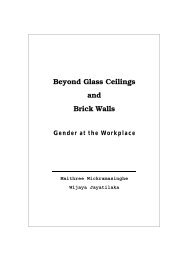SETP No. 14 The Economic Value of Incremental Employment in the ...
SETP No. 14 The Economic Value of Incremental Employment in the ...
SETP No. 14 The Economic Value of Incremental Employment in the ...
You also want an ePaper? Increase the reach of your titles
YUMPU automatically turns print PDFs into web optimized ePapers that Google loves.
ii) <strong>the</strong>re are benefits to those sectors on which <strong>the</strong> construction <strong>in</strong>dustry itself relies -<br />
most notably <strong>the</strong> build<strong>in</strong>g materials <strong>in</strong>dustry.<br />
1.12 In o<strong>the</strong>r words, <strong>the</strong>re are both backward and forward economic l<strong>in</strong>kages which<br />
may justify <strong>in</strong>creased spend<strong>in</strong>g on labour <strong>in</strong> construction. <strong>The</strong> key question is<br />
what such l<strong>in</strong>kages <strong>of</strong>fer <strong>in</strong> terms <strong>of</strong> aggregate economic benefits? If <strong>the</strong> benefits<br />
<strong>of</strong> us<strong>in</strong>g more labour are strong, <strong>the</strong> government can take a policy decision. As a<br />
key client <strong>of</strong> <strong>the</strong> construction <strong>in</strong>dustry, it may decide to reap <strong>the</strong> economic<br />
advantage <strong>of</strong> employment by means <strong>of</strong> pay<strong>in</strong>g a f<strong>in</strong>ancial premium for a<br />
construction process which substitutes more labour for equipment than <strong>the</strong><br />
<strong>in</strong>dustry itself would o<strong>the</strong>rwise choose.<br />
Scope <strong>of</strong> Work<br />
1.13 <strong>The</strong> scope <strong>of</strong> work is determ<strong>in</strong>ed by <strong>the</strong> Terms <strong>of</strong> Reference: <strong>The</strong> research to be<br />
undertaken will aim to provide an answer to <strong>the</strong> follow<strong>in</strong>g question:<br />
• what - if any - f<strong>in</strong>ancial premium per unit <strong>of</strong> expenditure on<br />
construction is economically justified for <strong>the</strong> substitution <strong>of</strong> labour<br />
for equipment?<br />
1.<strong>14</strong> <strong>The</strong> research will focus on <strong>the</strong> fronts <strong>of</strong> both labour and equipment, as <strong>in</strong>dicated<br />
below.<br />
Labour <strong>Economic</strong>s<br />
1.15 <strong>The</strong> start<strong>in</strong>g po<strong>in</strong>t for work on this front will be to analyse regional differences <strong>in</strong><br />
wage levels <strong>in</strong> relation to prevail<strong>in</strong>g costs <strong>of</strong> liv<strong>in</strong>g (<strong>in</strong> terms <strong>of</strong> a standard<br />
consumption 'basket'). What, if any, are <strong>the</strong> real differences <strong>in</strong> wage levels (or<br />
earn<strong>in</strong>g levels among those paid on a piece-work or task-work basis) <strong>in</strong><br />
construction -say, for (a) a skilled bricklayer, and (b) an unskilled labourer - <strong>in</strong><br />
Western Cape, Eastern Cape and <strong>No</strong>r<strong>the</strong>rn Prov<strong>in</strong>ces?<br />
1.16 At <strong>the</strong> next level <strong>of</strong> detail, <strong>the</strong> research will explore <strong>the</strong> likely primary directions <strong>of</strong><br />
expenditure among those employed under a labour-<strong>in</strong>tensive policy framework<br />
set by <strong>the</strong> government. What shares <strong>of</strong> <strong>in</strong>cremental <strong>in</strong>come are likely to be spent<br />
on food, cloth<strong>in</strong>g, house improvements and <strong>the</strong> like?<br />
1.17 <strong>The</strong> outcome <strong>of</strong> <strong>the</strong> analysis <strong>of</strong> labour economics will be to establish a multiplier<br />
effect for wages <strong>in</strong> construction.<br />
Equipment <strong>Economic</strong>s<br />
1.18 Most develop<strong>in</strong>g countries are obliged to import any equipment to be used <strong>in</strong> <strong>the</strong><br />
construction <strong>in</strong>dustry. As such, <strong>the</strong> economics <strong>of</strong> equipment utilisation are set by<br />
<strong>the</strong> opportunity cost <strong>of</strong> scarce foreign exchange. In South Africa, however, <strong>the</strong>re<br />
is already a domestic construction equipment manufactur<strong>in</strong>g <strong>in</strong>dustry. This is<br />
dom<strong>in</strong>ated by Bell Equipment, though o<strong>the</strong>r brands <strong>of</strong> equipment are imported.<br />
<strong>The</strong> research will establish <strong>the</strong> proportion <strong>of</strong> <strong>the</strong> value <strong>of</strong> demand for equipment<br />
that is satisfied by domestic manufacture versus imported items.<br />
1.19 Of course, <strong>the</strong> domestic manufacture <strong>of</strong> construction also has employment<br />
benefits, albeit only a limited number <strong>of</strong> relatively high wage-earn<strong>in</strong>g<br />
opportunities. <strong>The</strong> research will calculate a multiplier effect for earn<strong>in</strong>gs <strong>in</strong> this<br />
67
















